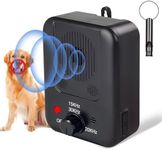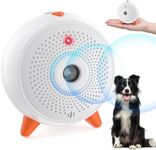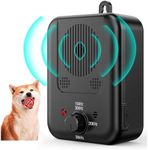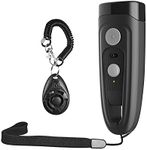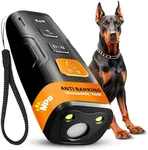Buying Guide for the Best Anti Barking Devices
Choosing the right anti-barking device for your dog can make a big difference in managing unwanted barking while keeping your pet comfortable and safe. The key is to understand how these devices work, what features matter most, and how your dog's temperament and environment should guide your decision. By focusing on the main specifications, you can find a device that is both effective and humane for your specific situation.Type of CorrectionThe type of correction refers to how the device discourages barking, such as sound, vibration, spray, or static stimulation. This is important because different dogs respond better to different types of correction, and some methods are more gentle than others. Sound and vibration are generally milder and suitable for sensitive or small dogs, while spray and static options may be more effective for stubborn barkers. Consider your dog's personality and sensitivity when choosing the correction type; gentle dogs may do well with sound or vibration, while persistent barkers might need a stronger deterrent.
Sensitivity LevelsSensitivity levels determine how easily the device is triggered by barking. This matters because a device that's too sensitive may activate from other noises, while one that's not sensitive enough might not respond to your dog's barking. Devices often offer adjustable sensitivity, which lets you fine-tune the response. If your dog barks softly or only occasionally, a lower sensitivity may be best. For loud or frequent barkers, a higher sensitivity ensures the device activates when needed.
Range of OperationThe range of operation describes how far the device can detect barking or, for remote-controlled models, how far away you can be to activate it. This is important for both indoor and outdoor use. Short-range devices are ideal for small apartments or single rooms, while longer-range options are better for large homes or yards. Think about where your dog spends most of its time and choose a range that covers those areas.
Power SourceThe power source indicates whether the device runs on batteries, is rechargeable, or plugs into an outlet. This affects convenience and where you can use the device. Battery-powered and rechargeable devices are portable and good for outdoor or travel use, while plug-in models are best for stationary indoor use. If you need flexibility, look for rechargeable or battery options; for a fixed spot, a plug-in device may be more practical.
Water ResistanceWater resistance shows how well the device can handle exposure to water or moisture. This is crucial if your dog spends time outdoors or if the device might get wet. Devices with higher water resistance are suitable for outdoor use and rainy conditions, while those with little or no water resistance should be kept indoors. Match the water resistance level to your dog's environment to ensure durability and safety.
Size and FitSize and fit refer to how well the device suits your dog's size, especially for collar-based models. This is important for comfort and effectiveness. Devices come in different sizes for small, medium, and large dogs. Make sure to choose one that fits your dog's neck comfortably and is not too heavy or bulky. For very small or very large dogs, check the manufacturer's recommendations to ensure a proper fit.
